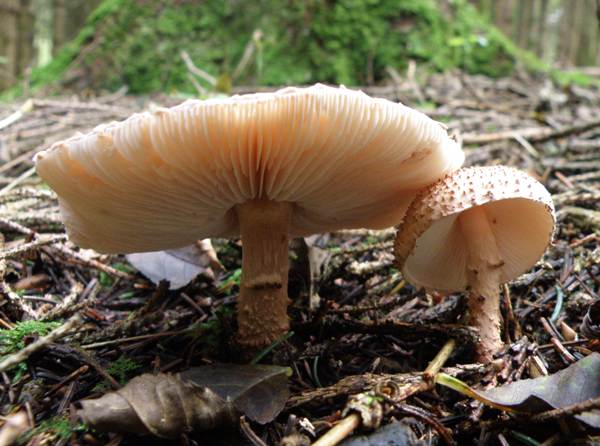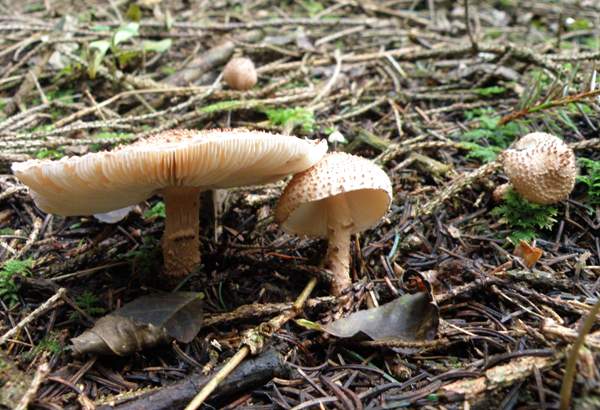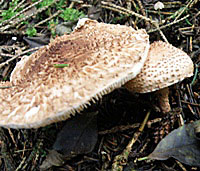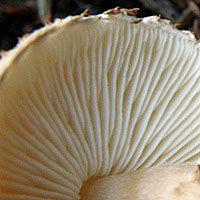Echinoderma echinaceum (J. E. Lange) Bon
Phylum: Basidiomycota - Class: Agaricomycetes - Order: Agaricales - Family: Agaricaceae
Distribution - Taxonomic History - Etymology - Identification - Culinary Notes - Reference Sources

A rare find, this lovely dapperling favours mixed woodland on calcareous soil. The pointed scales on the cap, the fragmentary stem ring, and intermediate gills of varying sizes all help to differentiate between Echinoderma echinaceum and the many other similar smallish pale-capped dapperlings.
Formerly included in the genus Lepiota, this dapperling appears in some field guides under its synonym Lepiota ecinacea.

Distribution
Echinoderma echinaceum is quite a rare find in Britain and Ireland, but it occurs in greater abundance in some parts of mainland Europe. I can find no record of this species being reported from North America.
Taxonomic history
This remarkable but sadlyall too seldom seen mushroom was described scientifically in 1940 by Danish mycologist Jakob Emanuel Lange (1864 - 1941), who gave it the binomial name Lepiota erinacea. Its currently-accepted scientific name, Echinoderma echinaceum, dates from a 1991 publication by French mycologist Marcel Bon (b. 1925).
Synonyms of Echinoderma echinaceum include Lepiota echinacea J. E. Lange, and Cystolepiota echinacea (J. E. Lange) Knudsen.
Etymology
The generic name Echinoderma comes from echin- meaning spiny or prickly (Sea Urchins belong to the class Echinoidea, which comes from the same stem); and -derma meaning skin. This mushroom genus certainly does contain spiny-skinned fungi. As far as I can tell the specific epithet echinaceum merely re-emphasises the spiny characteristic of this mushroom.
Identification guide
 |
CapConical then convex or bell-shaped and finally expanded with a broad umbo; cream or ochre background covered in pyramidal brown scales 1-2mm tall in concentric rings. Cap diameter at maturity ranges from 1.5 to 5cm. |
 |
GillsThe free, crowded gills are pinkish cream, becoming browner with age; they are interspersed by intermediate gills of varying lengths. Stem2 to 4cm long and 2.5 to 8mm in diameter; pinkish, the lower part covered in pointed brown scales, darkening towards base. The woolly stem ring is fragmentary.
|
SporesOblong to ellipsoidal, smooth, 4-5.5 x 2.5-3; dextrinoid. Spore printWhite or very pale buff. |
|
Odour/taste |
Slightly unleasant odour; mild but unpleasant taste. |
Habitat & Ecological role |
Solitary or in small groups in mixed woodland on chalk-rich soil. |
Season |
July to October in Britain and Ireland. |
Occurrence |
Uncommon. |
Similar species |
Lepiota ignivolvata has a bright orange or red-brown ring low down on the stem. |
Culinary Notes
Echinoderma echinaceum is not a common find and its edibility is dubious. This used to be included in the genus Lepiota, wherein many of the species are known to be deadly poisonous. For this reason we recommend that Echinoderma echinaceum should be treated as a toxic toadstool and should definitely not be gathered for eating.
Reference Sources
Fascinated by Fungi, 2nd Edition, Pat O'Reilly 2016, reprinted by Coch-y-bonddu Books in 2022.
Knudsen H., Vesterholt J. (eds) Funga Nordica: agaricoid, boletoid and cyphelloid genera - Nordsvamp, 2008
Dictionary of the Fungi; Paul M. Kirk, Paul F. Cannon, David W. Minter and J. A. Stalpers; CABI, 2008
Taxonomic history and synonym information on these pages is drawn from many sources but in particular from the British Mycological Society's GB Checklist of Fungi.
Fascinated by Fungi. Back by popular demand, Pat O'Reilly's best-selling 450-page hardback book is available now. The latest second edition was republished with a sparkling new cover design in September 2022 by Coch-y-Bonddu Books. Full details and copies are available from the publisher's online bookshop...

